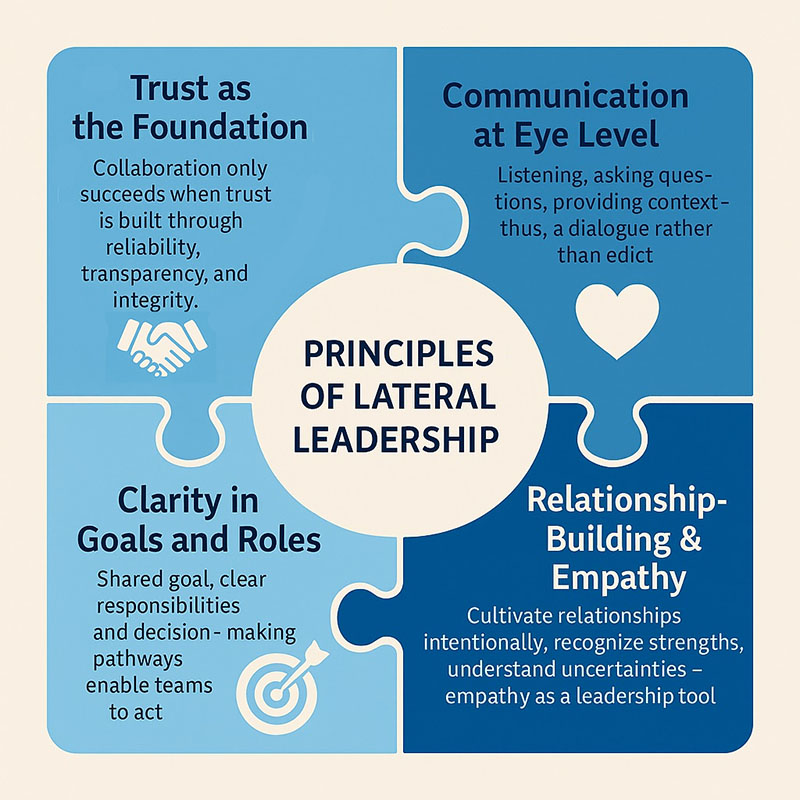Lateral leadership in everyday working life
Expand the table of contents
Why lateral leadership is becoming increasingly important
Principles of lateral leadership
Typical practical examples of lateral leadership
Challenges and stumbling blocks
Self-leadership: Leading starts with yourself
Conclusion: Lateral leadership as a skill for the future
FAQ: Lateral leadership
How to exert influence without formal power
Leading without power sounds like a paradox at first. But for many people, it has long been a reality in their everyday working lives. Scrum Masters, project managers, HR managers and specialists in cross-functional teams regularly face the same challenge: they are expected to provide guidance, drive decisions forward and secure results without having anyone formally reporting to them.
In traditional hierarchies, this would have been unthinkable, because leadership meant above all giving instructions and monitoring compliance. However, modern organisations function differently. They are more networked, agile and dynamic. The less rigid the structures are, the more important it becomes to have leadership that is based not on authority, but on influence and trust.
This is precisely where the concept of lateral leadership comes in. It describes a form of leadership based on communication, understanding and relationship building. This article explains why this has long been a decisive success factor for companies and how you can successfully practise lateral leadership in your everyday life.
Differences between lateral leadership and traditional leadership with authority
When we talk about lateral leadership, the first question that quickly arises is: How does it actually differ from traditional leadership with authority?
In hierarchical structures, the situation is clear: whoever holds the position also has the power. Tasks are assigned, decisions are made and their implementation is monitored. The manager sets the direction and the employees follow.
With lateral leadership, this is fundamentally different. Here, there is no formal basis of power. No one is officially subordinate to you. No one is obliged to follow your instructions. This is precisely where the particular challenge lies: you lead without being able to rely on titles or hierarchy.
In concrete terms, this means:
- Instead of instructions, you rely on persuasion.
- Instead of control, you rely on responsibility.
- Instead of authority through position, you need authority through competence.
Lateral leadership is based on influence. This is created through clarity, communication and relationships. Your role is not to command people, but to give them guidance, clarify common goals and facilitate cooperation.
The separation of influence and formal power is more important today than ever before because organisations are changing noticeably:
- Teams are increasingly working in an agile and self-organised manner.
- Technical expertise often carries more weight than hierarchical position.
- Responsibility is increasingly shifting to projects or networks rather than traditional departments.
Anyone who understands this principle quickly realises that lateral leadership is not a stopgap measure. It is a conscious and forward-looking approach to how collaboration can be successful even without a traditional hierarchy.
Why lateral leadership is becoming increasingly important
Just a few decades ago, leadership was almost exclusively a question of hierarchy. The boss made the decisions and everyone else had to follow. Those days are over.
Today, companies are operating in a completely new reality:
- Agile methods such as Scrum or Kanban focus on personal responsibility.
- Hybrid teams work across locations and national borders.
- Project work is gaining importance over rigid line organisations.
In this working environment, it is no longer enough to rely solely on disciplinary power. Too much control from above slows down speed, innovation and motivation.
The IW Report 19/2024 ‘Leadership in Transformation’ shows that companies are increasingly relying on lateral leadership to successfully manage complex changes. [1] The Global Leadership Forecast 2025 also emphasises how crucial human connection, trust and authentic leadership are in times of accelerated change. [2] Today, success is based less on formality and more on reliability and genuine relationships.
Lateral leadership offers advantages that traditional hierarchies can hardly match:
- Employees are more involved because they follow voluntarily rather than just fulfilling their duties.
- Personal responsibility increases because decisions are made jointly within the team.
- Innovation increases because diversity of perspectives is not restricted by rigid instructions.
Lateral leadership is thus a response to the complexity of modern organisations. It enables collaboration on an equal footing, especially where formal power structures are ineffective or even hindering.
Principles of lateral leadership
Lateral leadership does not work through titles or orders, but through inner attitude and certain basic principles. Those who understand and live by these principles can gain real influence even without formal power.
1. Trust as a basis
Without trust, there can be no cooperation. In lateral leadership, this means that you earn the trust of your colleagues by acting reliably, communicating transparently and behaving with integrity. People follow you because they are convinced, not because they are obliged to.
2. Communication at eye level
While hierarchical communication often flows from the top down, lateral leadership thrives on dialogue.
- You listen actively.
- You ask questions instead of giving ready-made answers.
- You explain the background and make goals visible.
- This creates a common ground that makes genuine cooperation possible.
3. Clarity in goals and roles
When formal power is lacking, clarity becomes particularly important:
- What is the common goal?
- Who takes on which responsibilities?
- Which decisions are made and how?
This clarity protects against misunderstandings and enables teams to take action. In my coaching sessions, I often find that this is exactly where the knot is untied. As soon as teams create clarity together, many misunderstandings resolve themselves. Sometimes it is enough to formulate the goals in a single sentence that everyone can understand, and suddenly everyone is pulling in the same direction.
Exercise: Formulate a team goal without instructions
Take five minutes and choose a current goal from your team. Formulate it in such a way that it is based on shared responsibility rather than instructions.
1. Write down the goal.
Example: ‘Complete the customer report by the end of the month.’
2. Formulate it without using ‘I decide’ or ‘you must’.
Instead: ‘We want to complete the customer report together by the end of the month.’
3. Add what each person can contribute.
Example: ‘Alex will take care of the analysis, Fatima will create the visualisations, and I will moderate the coordination.’
4. Check the effect.
Does the goal sound like it invites everyone to take responsibility instead of just following instructions?
With this little exercise, you can practise shifting your perspective from authoritative leadership to lateral leadership.
4. Relationship building and empathy
Lateral leadership always means actively building relationships. You invest in connections, recognise strengths and show understanding for uncertainties. Empathy is not just a ‘nice to have’ but a key leadership tool.
In short, lateral leadership succeeds when you consciously use trust, communication, clarity and relationships. This sounds simple at first, but often proves to be a real challenge in practice.
Figure: Principles of lateral leadership
Typical practical examples of lateral leadership
You may be wondering: where exactly do I encounter lateral leadership in everyday life? The answer is: much more often than most people realise. In modern organisations, it has long been part of everyday working life, even if it is not always referred to as such.
Scrum Masters
Scrum Masters are a prime example of lateral leadership. They have no formal authority, but they have a decisive influence on how efficiently, motivated and focused a team works together. Their impact is based on moderation, communication and the ability to remove obstacles.
Practical example: The lateral leadership of a Scrum Master
Anna is a Scrum Master in a cross-functional team. No one reports to her formally, yet she is responsible for ensuring that the team remains productive and deadlines are met.
When two team members argue about priorities and the sprint threatens to fail, Anna cannot give instructions. Instead, she moderates the conversation, asks questions, makes the goals transparent and gives both sides space to present their perspectives. In the end, the participants agree on a common path. Not because they had to, but because they were convinced.
This is precisely where the strength of lateral leadership lies: it works through communication, clarity and trust.
Project managers without disciplinary responsibility
Project managers have to manage projects, meet deadlines and organise coordination, often without disciplinary authority. Whether a project stalls or gains momentum depends heavily on persuasiveness, prioritisation and clear communication.
HR managers
Lateral leadership is also evident in HR roles. Whether it’s personnel development, diversity or corporate culture, HR departments rarely have the authority to issue orders. They must convince managers and employees, build trust and shape relationships.
Cross-functional teams
Cross-functional teams bring together people from different departments, often with very different skills, experiences and perspectives. For collaboration to succeed, someone is needed to build bridges, moderate discussions and make common goals visible. This, too, is lateral leadership in its purest form.
These examples show that lateral leadership is not an exception. It has long been part of modern collaboration and shapes everyday life in many organisations.
Challenges and stumbling blocks
As valuable as lateral leadership is, it also comes with its own challenges. Without formal power, you will quickly reach your limits if certain conditions are not met.
Gaining acceptance within the team
Without a title to back you up, you have to earn authority step by step. Some team members will deliberately test how far your influence actually extends. In such situations, it is important to remain consistent, develop a clear stance and at the same time be open to feedback.
Resolving conflicts without power
In traditional hierarchies, the manager often makes the decisions. This does not work in lateral leadership. Moderating conflicts, balancing interests and finding viable solutions is challenging, but it also offers a great opportunity to build trust and team spirit.
I remember a project team that was on the verge of falling out because everyone wanted to have the last word. It was only when we entered into a moderated discussion that a solution emerged. It took more time, but it was much more sustainable because everyone supported it.
Recognising the limits of your own influence
Lateral leadership thrives on communication and relationships, but not everything can be solved with these. Sometimes formal decisions, clear statements or even escalations are necessary. Recognising where your influence ends is just as important as using it courageously.
Balance between closeness and distance
A common stumbling block is an excessive need for harmony. Those who want to please everyone lose clarity. Lateral leadership requires closeness and understanding, but at the same time the ability to speak uncomfortable truths.
In short: Lateral leadership is a balancing act. It moves between influence and boundaries, between closeness and clarity, between trust and assertiveness.
Self-leadership: Leading starts with yourself
One of the most important findings of modern research on lateral leadership is that if you want to lead others without formal power, you must first learn to lead yourself.
Self-awareness
It all starts with a clear view of yourself.
- What strengths do you bring to the table?
- Where are your limits?
- What patterns shape your behaviour in stressful situations?
Only when you know yourself well can you come across as authentic and credible.
Personal responsibility
Lateral leadership means taking responsibility, even without an official mandate. Decisions are not postponed, but actively shaped. Personal responsibility is demonstrated by acting instead of waiting for official instructions.
Self-regulation
Especially without formal power, it is crucial to deal with your own emotions and impulses consciously. Those who remain calm when conflicts escalate gain trust. Those who communicate reflectively instead of reacting spontaneously build credibility.
Resilience as a key competence
Leadership without power is challenging. You will encounter resistance, uncertainty and frustration. Resilience, i.e. the ability to cope with setbacks and emerge stronger from them, is therefore a central component of self-leadership.
Role model
People follow not only your arguments, but also your behaviour. When you exemplify self-leadership, you inspire others to do the same. This creates a form of natural authority that does not require titles.
Self-leadership is therefore not an extra, but the foundation on which lateral leadership is built.
Conclusion: Lateral leadership as a skill for the future
Lateral leadership is no longer a niche topic, but rather part of everyday life in modern organisations. Wherever people work together without clear hierarchies, leadership becomes a question of influence, communication and trust, not authority.
Examples from Scrum, project management, HR and cross-functional teams make it clear that this form of leadership determines whether collaboration stalls or succeeds. Studies such as the IW Report 2024 and the Haufe Analysis 2025 show that companies that promote lateral leadership gain in agility, innovative strength and employee retention.
At the same time, there are pitfalls. Without formal power, clarity, empathy, conflict management skills and, above all, the ability to lead oneself are required. Self-leadership is thus becoming a key skill for the future. Those who manage themselves reflectively, take responsibility and develop resilience can also effectively support others without hierarchy.
Ultimately, leadership today means much more than exercising formal power. It means placing trust in others, providing guidance and winning people over to common goals on an equal footing. This is precisely what makes lateral leadership so valuable – for you, your team and the future of your organisation.
I am convinced that the ability to make an impact even without a title will be one of the key skills of the coming years. And the beauty of it is that anyone can learn it. It starts small, in everyday life, and grows with every conscious decision to trust rather than control.
FAQ: Lateral leadership
Here you will find a brief summary of some questions and answers about lateral leadership:
What does lateral leadership mean?
Lateral leadership describes leadership without formal authority. It is based on trust, communication and influence rather than hierarchy and orders.
Why is lateral leadership so important?
Agile, hybrid and cross-functional teams often do not have traditional hierarchies. Lateral leadership provides guidance and enables collaboration even without titles.
Where does lateral leadership occur in practice?
Typical examples include Scrum Masters, project managers without disciplinary responsibility, HR roles, or cross-functional teams.
What skills do you need for lateral leadership?
Communication on equal terms, empathy, clarity in goals and roles, and self-leadership are particularly important. This includes self-awareness, personal responsibility and resilience.
What are the biggest challenges in lateral leadership?
The most common pitfalls include acceptance within the team, resolving conflicts without power, striking a balance between closeness and distance, and recognising one’s own limits.
Notes (partly in German):
[1] Institut der deutschen Wirtschaft (IW) (2024): Fuehrung in der Transformation. IW-Report 19/2024.
[2] DDI – Development Dimensions International (2025): Global Leadership Forecast 2025.
Stefan Brandt offers a free German-language leadership guide for download on his attractive website: 17 Fehler, die JEDE neue Führungskraft macht – wie du sie vermeidest.
This is a Top Blog Post 2025.
Would you like to discuss lateral leadership as a multiplier? Then share this post in your network.

Stefan Brandt
Stefan Brandt is a qualified psychologist, leadership expert and coach. For many years, he has been supporting managers and teams in change processes and demonstrating how cooperation can succeed even without traditional hierarchies. In his articles, he combines psychological insights with practical experience and future trends, while always keeping an eye on what is feasible.
In the t2informatik Blog, we publish articles for people in organisations. For these people, we develop and modernise software. Pragmatic. ✔️ Personal. ✔️ Professional. ✔️ Click here to find out more.

